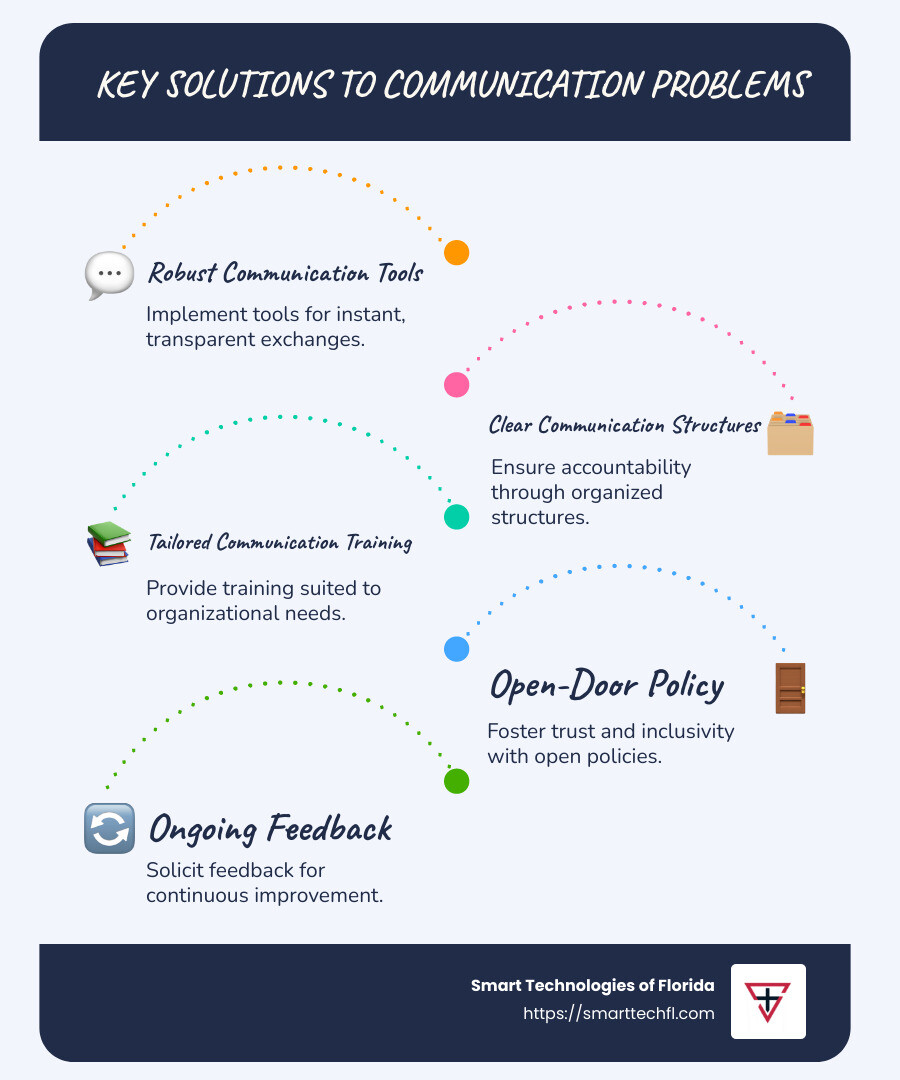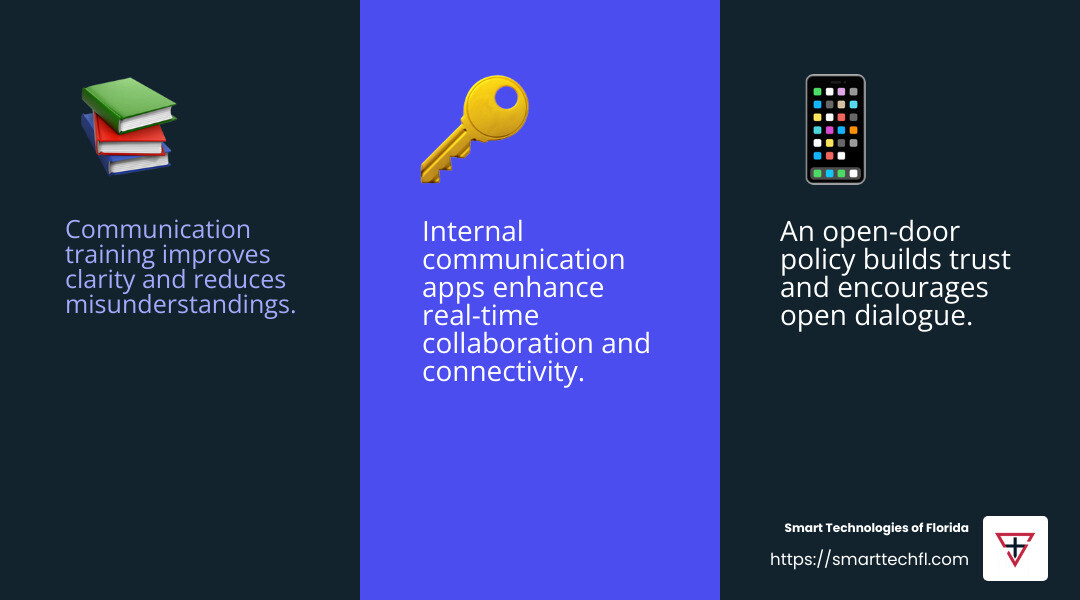From Miscommunication to Mastery: Solving Business Communication Problems
Business communication solutions are more crucial today than ever. As companies steer the complexities of modern workplace dynamics, effective communication has emerged as both a challenge and a necessity. Addressing these challenges can empower businesses to thrive in an changing environment. Here’s a quick overview of key solutions:
- Implement robust communication tools for instant, transparent exchanges.
- Establish clear communication structures to ensure accountability.
- Provide communication training custom to organizational needs.
- Encourage an open-door policy to foster trust and inclusivity.
- Solicit ongoing feedback for continuous improvement.
Miscommunication can lead to misunderstandings, low morale, and decreased productivity. With the shift to hybrid work models, the need for connectedness and clarity has become even more pronounced. As highlighted by Graham Glass, founder & CEO of CYPHER LEARNING, swift adaptation to changing communication landscapes is vital. By addressing and solving communication problems, companies can create a culture of transparency, collaboration, and engagement.
Workplace dynamics continue to transform, fueled by advances in technology and changing employee expectations. Business owners at Smart Technologies of Florida recognize that effective communication is a core element for success. Whether it’s overcoming physical barriers or clarifying leadership roles, effective communication strategies ensure that employee morale and productivity remain high.

Identifying Common Communication Problems
In the business world, communication problems can derail even the most well-planned strategies. Let’s dig into some common issues that businesses face and how they can impact your organization.
Poor Feedback
Feedback is crucial for growth and improvement. But when feedback is sparse or unclear, employees feel undervalued and lost. Imagine working hard all year, only to hear feedback during an annual review. This lack of regular feedback can lead to repeated mistakes, low morale, and high turnover.

Fuzzy Goals
Clear goals are like a roadmap. They guide employees and align their efforts with company objectives. But when goals are vague or unspoken, confusion takes over. Employees are left guessing what success looks like, leading to frustration and inefficiency. This lack of direction can result in missed deadlines and unmet targets.
Unmotivated Employees
Motivation is the fuel that keeps employees engaged and productive. When employees don’t feel valued or respected, they lose interest. This lack of motivation can cause misunderstandings, mistakes, and missed opportunities. It also leads to a toxic work environment where communication breaks down.
Unclear Leadership
Leadership sets the tone for communication. When leaders struggle to make decisions or communicate objectives, it creates a ripple effect of confusion. Employees are unsure of their roles and responsibilities, leading to mistakes and low morale. Clear, decisive leadership is essential to keep everyone on the same page and moving in the right direction.
Addressing these communication problems is crucial for business success. By recognizing and tackling these issues, companies can foster a more productive and harmonious workplace.
Business Communication Solutions
Effective communication is the backbone of any successful business. Let’s explore some practical solutions for communication problems in business that can transform your workplace into a more cohesive and efficient environment.
Communication Training
Investing in communication training is one of the smartest moves a company can make. Programs like ASU CareerCatalyst’s Professional Skills for Everyone Series offer online courses that teach essential communication skills. These courses cover everything from collaboration to conflict management, equipping employees with the tools they need to communicate effectively.
Why is this important? Employees with strong communication skills can express their ideas clearly and listen actively, leading to fewer misunderstandings and more productive interactions.
Open-Door Policy
An open-door policy creates a safe space for employees to share their thoughts, concerns, and ideas. This approach encourages open dialogue and helps build trust between staff and management. When employees feel heard, they are more engaged and motivated.
How does it work? Encourage managers to keep their doors open or set regular times when employees can drop by to discuss any issues. This fosters a culture of transparency and openness, reducing the barriers to effective communication.
Internal Communication Apps
Internal communication apps like Slack can revolutionize the way teams interact. These apps provide instant messaging, file sharing, and even video conferencing, making it easier for employees to stay connected.
The benefit? These tools streamline communication, reduce email overload, and enable real-time collaboration. When employees have the right tools, they can communicate more efficiently and stay aligned with company goals.
Feedback Systems
Regular feedback is essential for continuous improvement and employee satisfaction. Implementing structured feedback systems can help ensure that feedback is timely, constructive, and actionable.
What does this look like? Use digital tools like Beekeeper to conduct surveys and polls, allowing employees to provide feedback anonymously. This not only helps in identifying areas for improvement but also empowers employees by giving them a voice in the organization.
By adopting these solutions for communication problems in business, companies can create a more open, efficient, and harmonious work environment. These strategies not only improve communication but also boost employee morale and productivity, paving the way for business success.

Next, we’ll dig into how technology can be leveraged to further improve communication in the workplace.
Leveraging Technology for Better Communication
In today’s world, technology is a game-changer for business communication. Let’s explore how leveraging the right tools can solve communication problems and boost productivity.
Communication Tools
Modern communication tools like Microsoft Teams and Zoom have become essential. They offer video conferencing, chat, and file sharing all in one place. This makes it easy for teams to stay connected, regardless of where they are.
Why use them? These tools reduce the need for endless email chains and allow for quick, real-time interactions. They help teams collaborate better and make decisions faster.
Cloud Collaboration
Cloud collaboration platforms such as Google Workspace and Dropbox revolutionize how teams work together. They allow employees to access and edit documents from anywhere, at any time.
The advantage? This flexibility means that teams can work on projects simultaneously, without the hassle of version control. It keeps everyone on the same page and speeds up project timelines.
Mobile Communication
In our mobile-driven world, mobile communication tools are crucial. Apps like Slack and WhatsApp enable employees to communicate on the go, ensuring that important updates are never missed.
What’s the benefit? Mobile communication keeps everyone in the loop, even when they’re away from their desks. It improves responsiveness and ensures that employees can collaborate effectively, no matter where they are.
By using these technologies, businesses can tackle communication challenges head-on. They provide the infrastructure needed for seamless interaction, ultimately leading to a more connected and efficient workplace.
Next, let’s explore how building a culture of open communication can further improve your business’s communication strategies.
Building a Culture of Open Communication
Creating a culture of open communication is key to solving business communication problems. It starts with psychological safety. Employees need to feel safe to express their ideas and concerns without fear of judgment or retaliation. This sense of safety encourages more honest and productive conversations.
How can you foster psychological safety? Lead by example. Admit when you don’t know something or when you’ve made a mistake. This shows your team that it’s okay to be vulnerable and that learning is a shared journey.
Another important aspect is providing a safe space for communication. An open-door policy can be very effective here. It signals to employees that their voice matters and that they can approach leadership with questions or feedback at any time. This openness can lead to faster problem-solving and innovation.
Two-way communication is crucial. It’s not just about giving orders; it’s about listening too. Regular check-ins and feedback sessions are great for this. They allow employees to share their thoughts and for managers to gain insights into team dynamics.
Why does two-way communication matter? It builds trust and engagement. When employees feel heard, they’re more likely to be motivated and aligned with company goals. This communication loop ensures that everyone is on the same page and working towards a common purpose.
By focusing on these elements, businesses can create a robust culture of open communication. This foundation not only addresses current communication issues but also prepares the organization to adapt to future challenges.
Next, we’ll tackle some common questions about communication solutions to further clarify how to implement these strategies in your business.
Frequently Asked Questions about Communication Solutions
What are the 5 C’s of communication?
The 5 C’s of communication are crucial for effective business interactions. They ensure messages are delivered clearly and understood by everyone involved.
- Clear: Use simple language and avoid jargon. Everyone should understand the message without needing extra explanation.
- Cohesive: Ensure the message is logical and consistent. All parts should connect smoothly, so there’s no confusion.
- Complete: Provide all necessary information. This prevents back-and-forth questions and speeds up decision-making.
- Concise: Get to the point quickly. Long-winded messages can lose the audience’s attention.
- Concrete: Use specific facts and figures. This makes the message more credible and easier to act upon.
How can businesses improve communication with remote employees?
Improving communication with remote employees is vital in today’s work environment. Here are some effective solutions:
- Video conferencing: Tools like Zoom and Microsoft Teams enable face-to-face interaction, which helps convey tone and body language.
- Chat apps: Slack and similar apps provide a quick way to ask questions and share updates. They keep conversations organized and accessible.
- Cloud tools: Platforms like Google Workspace and Microsoft 365 allow employees to collaborate in real-time, regardless of location. They make sharing documents and resources seamless.
These tools help bridge the gap between remote and on-site teams, ensuring everyone stays connected and informed.
What role does leadership play in solving communication problems?
Leadership is crucial in addressing communication challenges. Here’s how leaders can make a difference:
- Clear objectives: Leaders should set clear and achievable goals. This aligns everyone and reduces misunderstandings.
- Open communication: An open-door policy encourages employees to share their thoughts and concerns. It fosters an environment where everyone feels valued.
- Trust-building: Leaders who are transparent and consistent build trust. This trust encourages employees to communicate openly and collaborate effectively.
By focusing on these areas, leaders can create a supportive environment that encourages open and effective communication, helping solve business communication problems.
Conclusion
At Smart Technologies of Florida, we understand that effective communication is the backbone of any successful business. As a Business Change Agency, our mission is to empower organizations through strategic change and a people-centric approach.
With 23 years of experience, we have seen how poor communication can derail even the best-laid plans. However, we also know that with the right tools and strategies, communication problems can be transformed into opportunities for growth and innovation.
Our solutions for communication problems in business are not just about implementing the latest technology. They are about creating an environment where open dialogue is encouraged, and every team member feels heard and valued. We believe in building a culture of trust and transparency, where feedback is not only welcomed but actively sought out.
Our approach is simple yet powerful:
- Strategic Change: We help businesses adapt to the changing digital landscape, ensuring that communication channels are not just efficient but also effective.
- People-Centric Approach: We prioritize the human element in all our solutions, recognizing that technology should serve people, not the other way around.
By leveraging our expertise and custom digital solutions, businesses can overcome communication barriers and achieve their unique goals.
For more information on how we can help your organization master communication, visit our Business Communication Solutions page. Let’s transform your communication challenges into strengths together.












